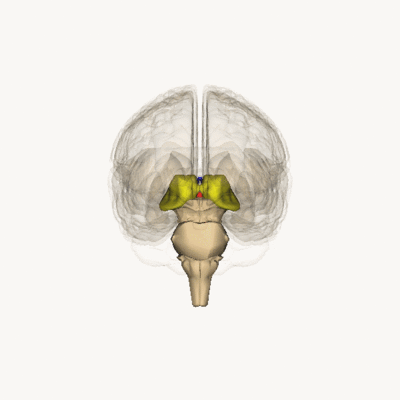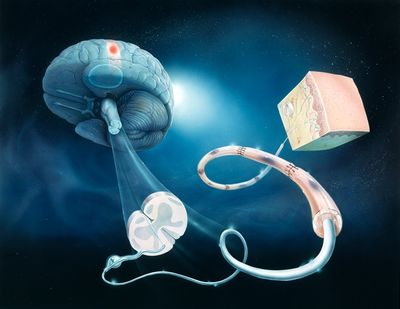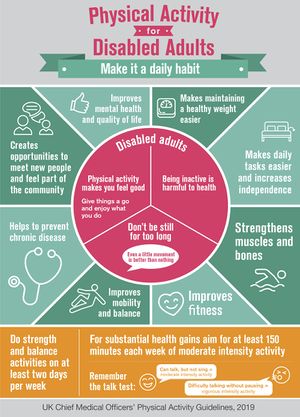Thalamus: Difference between revisions
Rucha Gadgil (talk | contribs) No edit summary |
No edit summary |
||
| Line 4: | Line 4: | ||
'''Top Contributors''' - {{Special:Contributors/{{FULLPAGENAME}}}} | '''Top Contributors''' - {{Special:Contributors/{{FULLPAGENAME}}}} | ||
</div> | </div> | ||
== Introduction == | == Introduction to the Thalamus == | ||
[[File:Thalamus.gif|400x400px|alt=|thumb|Rotation: brainstem and | [[File:Thalamus.gif|400x400px|alt=|thumb|Rotation: brainstem and thalamu]]The thalamus is located medial to the cerebrum. It is a pair of egg-shaped structures which functions as a relay station for motor and sensory information moving out and into the CNS. Motor pathways, [[Limbic System|limbic]] pathways, and sensory pathways (with the exception of olfaction) pass through this central structure. | ||
The thalamus | |||
== | * The thalamus transmits 98 percent of sensory information to the cortex, including vision, taste, touch and [[balance]]. | ||
* The thalamus also conducts motor signals from the cerebral cortex to the spinal cord and ultimately to the peripheral nervous system. | |||
* The thalamus also functions to relay information from the [[Brainstem|brain stem]] to the cortex, coordinating shifts in consciousness such as waking up and falling asleep.<ref name=":0">Halassa, M.M., Kastner, S. Thalamic functions in distributed cognitive control. ''Nat Neurosci, 2017;'' 20, 1669–1679. </ref> | |||
The thalamus can be divided into approximately 60 regions known as '''thalamic nuclei'''. Each nucleus has unique pathways as inputs and various projections as outputs, most of which send information to the '''[[Cerebral Cortex|cerebral cortex]]'''.<ref name=":1" /> | |||
== Thalamic Function == | |||
[[File:Thalamus connections.jpg|right|frameless|400x400px]] | [[File:Thalamus connections.jpg|right|frameless|400x400px]] | ||
The thalamus is part of the [[Limbic System|limbic system]], the region of the brain largely associated with the emotions and is essential to memory and learning. | The thalamus is part of the [[Limbic System|limbic system]], the region of the brain largely associated with the emotions and is essential to memory and learning. | ||
The thalamus joins a series of other machinery whose purpose is to distill sensory information into a more interpretable and manageable form | The thalamus joins a series of other machinery whose purpose is to distill sensory information into a more interpretable and manageable form before transmitting it to higher brain areas. | ||
* The thalamus is engaged in an intimate relationship with the cerebral cortex, with numerous mutual connections. These connections make up the '''thalamacortical loop'''. | |||
* The thalamus also modulates arousal mechanisms, maintains alertness, and directs attention to sensory events.<ref name=":0" /> | |||
Functionally, the thalamus divides into five major functional components | |||
Functionally, the thalamus divides into five major functional components: | |||
# '''Reticular and intralaminar nuclei''' dealing with arousal and pain regulation. | |||
#* The reticular formation is constantly making intelligent guesses as to what sensory object is generating these activation patterns. | |||
#* The intralaminar circuit compares these pattern guesses with similar patterns in memory. | |||
#* All these circuits cooperate to produce a coherent framework for the interpretation of incoming sensory data. | |||
These specific nuclei are responsible for scanning the cerebral cortex and determining active brain regions | # '''Sensory nuclei''' regulating all sensory domains, except olfaction | ||
# '''Effector nuclei''' governing motor language function | |||
# '''Associative nuclei''' connoting cognitive functions | |||
# '''Limbic nuclei''' managing mood and motivation<ref name=":1">Torrico TJ, Munakomi S. Neuroanatomy, Thalamus. [Updated 2023 Jul 24]. In: StatPearls [Internet].</ref> | |||
These specific nuclei are responsible for scanning the cerebral cortex and determining active brain regions then relaying this information to the rest of the thalamus.<ref name=":0" /> | |||
== Thalamus and Injury == | == Thalamus and Injury == | ||
[[File:4-physical-activity-for-disabled-adults.jpeg|right|frameless]] | [[File:4-physical-activity-for-disabled-adults.jpeg|right|frameless]] | ||
The thalamus contributes to a broad range of critical functions | The thalamus contributes to a broad range of critical functions therefore injury to the thalamus can present clinical signs and symptoms unique to each individual. | ||
Some of the most common | '''Some of the most common symptoms of thalamic damage or dysfunction include:''' | ||
* Sensory issues such as tingling, numbness, hypersensitivity, and [[Pain Behaviours|pain]] | * Sensory issues such as tingling, numbness, hypersensitivity, and [[Pain Behaviours|pain]] | ||
* Vision loss or light sensitivity | * Vision loss or light sensitivity | ||
| Line 39: | Line 47: | ||
* Insomnia | * Insomnia | ||
* Impairments to proprioception | * Impairments to proprioception | ||
* Thalamic pain syndrome: an excruciating sensation of pain unresponsive to narcotics. Once called Dejerine-Roussy Syndrome, this condition is commonly associated with infarct affecting the ventroposterolateral thalamus <ref>Jahngir MU, Qureshi AI. [https://www.ncbi.nlm.nih.gov/books/NBK519047/ Dejerine roussy syndrome]. 2023.In: StatPearls [Internet]. </ref> <ref>Dydyk AM, Munakomi S. [https://www.ncbi.nlm.nih.gov/books/NBK554490/ Thalamic Pain Syndrome].[Updated 2023 Aug 13]. StatPearls [Internet]. Treasure Island (FL): StatPearls Publishing. 2023.</ref>. | |||
* [[Pusher Syndrome]]: a lesion to the posterior thalamus interrupts a connection to the vestibular nuclei, leading to lateropulsion in the direction of the impaired side. <ref>Rosenzopf H, Klingbeil J, Wawrzyniak M, Röhrig L, Sperber C, Saur D, Karnath HO. [https://academic.oup.com/brain/article-abstract/146/9/3648/7082493?redirectedFrom=fulltext&login=false Thalamocortical disconnection involved in pusher syndrome.] Brain. 2023;146(9):3648-3661.</ref> | '''Additional presentations unique to thalamic injury involve''': | ||
* Vegetative state and coma: a lesion to the non-specific (intralaminar and reticular) nuclei. <ref>Adams JH, Graham DI, Jennett B. [https://academic.oup.com/brain/article/123/7/1327/380151?login=false The neuropathology of the vegetative state after an acute brain insult.] Brain. 2000 Jul;123 (Pt 7):1327-38.</ref> Coma may occur due to the thalamus's impacts on sleep and arousal. | |||
* '''Thalamic pain syndrome''': an excruciating sensation of pain unresponsive to narcotics. Once called Dejerine-Roussy Syndrome, this condition is commonly associated with infarct affecting the ventroposterolateral thalamus <ref>Jahngir MU, Qureshi AI. [https://www.ncbi.nlm.nih.gov/books/NBK519047/ Dejerine roussy syndrome]. 2023.In: StatPearls [Internet]. </ref> <ref>Dydyk AM, Munakomi S. [https://www.ncbi.nlm.nih.gov/books/NBK554490/ Thalamic Pain Syndrome].[Updated 2023 Aug 13]. StatPearls [Internet]. Treasure Island (FL): StatPearls Publishing. 2023.</ref>. | |||
* [[Pusher Syndrome|'''Pusher Syndrome''']] (also referred to as "persons who push"): a lesion to the posterior thalamus interrupts a connection to the vestibular nuclei, leading to lateropulsion in the direction of the impaired side. <ref>Rosenzopf H, Klingbeil J, Wawrzyniak M, Röhrig L, Sperber C, Saur D, Karnath HO. [https://academic.oup.com/brain/article-abstract/146/9/3648/7082493?redirectedFrom=fulltext&login=false Thalamocortical disconnection involved in pusher syndrome.] Brain. 2023;146(9):3648-3661.</ref> | |||
* '''Vegetative state and coma''': a lesion to the non-specific (intralaminar and reticular) nuclei. <ref>Adams JH, Graham DI, Jennett B. [https://academic.oup.com/brain/article/123/7/1327/380151?login=false The neuropathology of the vegetative state after an acute brain insult.] Brain. 2000 Jul;123 (Pt 7):1327-38.</ref> Coma may occur due to the thalamus's impacts on sleep and arousal. | |||
== Physiotherapy Treatment == | == Physiotherapy Treatment == | ||
Treatment for thalamic damage will revolve around restoring the abilities lost after brain injury. | Treatment for thalamic damage will revolve around restoring the abilities lost after brain injury. Treatment is symptom specific, therefore thorough and ongoing therapy assessment is required for proper management and treatment. | ||
For more information, please read the following articles: | |||
* [[Overview of Traumatic Brain Injury|Traumatic Brain Injury]] | |||
* [[Traumatic Brain Injury Clinical Guidelines]] | |||
* [[Physiotherapy Management of Traumatic Brain Injury]] | |||
* [[Physical Activity Guidelines for Traumatic Brain Injury]] | |||
* [[Stroke: The Role of Physical Activity]] | |||
* [[Stroke: Clinical Guidelines]] | |||
* [[Post-Stroke Pain]] | |||
* [[Mirror Therapy]] | |||
* [[Pusher Syndrome#Management / Interventions|Management of pushing tendencies]] | |||
* [[Desensitization]] treatment for thalamic pain | |||
== References == | == References == | ||
Revision as of 19:40, 29 May 2024
Original Editor - Lucinda hampton
Top Contributors - Lucinda hampton, Jess Bell, Stacy Schiurring, Kirenga Bamurange Liliane, Uchechukwu Chukwuemeka, Vidya Acharya, Rucha Gadgil and Mason Trauger
Introduction to the Thalamus[edit | edit source]
The thalamus is located medial to the cerebrum. It is a pair of egg-shaped structures which functions as a relay station for motor and sensory information moving out and into the CNS. Motor pathways, limbic pathways, and sensory pathways (with the exception of olfaction) pass through this central structure.
- The thalamus transmits 98 percent of sensory information to the cortex, including vision, taste, touch and balance.
- The thalamus also conducts motor signals from the cerebral cortex to the spinal cord and ultimately to the peripheral nervous system.
- The thalamus also functions to relay information from the brain stem to the cortex, coordinating shifts in consciousness such as waking up and falling asleep.[1]
The thalamus can be divided into approximately 60 regions known as thalamic nuclei. Each nucleus has unique pathways as inputs and various projections as outputs, most of which send information to the cerebral cortex.[2]
Thalamic Function[edit | edit source]
The thalamus is part of the limbic system, the region of the brain largely associated with the emotions and is essential to memory and learning.
The thalamus joins a series of other machinery whose purpose is to distill sensory information into a more interpretable and manageable form before transmitting it to higher brain areas.
- The thalamus is engaged in an intimate relationship with the cerebral cortex, with numerous mutual connections. These connections make up the thalamacortical loop.
- The thalamus also modulates arousal mechanisms, maintains alertness, and directs attention to sensory events.[1]
Functionally, the thalamus divides into five major functional components:
- Reticular and intralaminar nuclei dealing with arousal and pain regulation.
- The reticular formation is constantly making intelligent guesses as to what sensory object is generating these activation patterns.
- The intralaminar circuit compares these pattern guesses with similar patterns in memory.
- All these circuits cooperate to produce a coherent framework for the interpretation of incoming sensory data.
- Sensory nuclei regulating all sensory domains, except olfaction
- Effector nuclei governing motor language function
- Associative nuclei connoting cognitive functions
- Limbic nuclei managing mood and motivation[2]
These specific nuclei are responsible for scanning the cerebral cortex and determining active brain regions then relaying this information to the rest of the thalamus.[1]
Thalamus and Injury[edit | edit source]
The thalamus contributes to a broad range of critical functions therefore injury to the thalamus can present clinical signs and symptoms unique to each individual.
Some of the most common symptoms of thalamic damage or dysfunction include:
- Sensory issues such as tingling, numbness, hypersensitivity, and pain
- Vision loss or light sensitivity
- Motor impairments
- Tremors
- Attention problems
- Memory loss
- Insomnia
- Impairments to proprioception
Additional presentations unique to thalamic injury involve:
- Thalamic pain syndrome: an excruciating sensation of pain unresponsive to narcotics. Once called Dejerine-Roussy Syndrome, this condition is commonly associated with infarct affecting the ventroposterolateral thalamus [3] [4].
- Pusher Syndrome (also referred to as "persons who push"): a lesion to the posterior thalamus interrupts a connection to the vestibular nuclei, leading to lateropulsion in the direction of the impaired side. [5]
- Vegetative state and coma: a lesion to the non-specific (intralaminar and reticular) nuclei. [6] Coma may occur due to the thalamus's impacts on sleep and arousal.
Physiotherapy Treatment[edit | edit source]
Treatment for thalamic damage will revolve around restoring the abilities lost after brain injury. Treatment is symptom specific, therefore thorough and ongoing therapy assessment is required for proper management and treatment.
For more information, please read the following articles:
- Traumatic Brain Injury
- Traumatic Brain Injury Clinical Guidelines
- Physiotherapy Management of Traumatic Brain Injury
- Physical Activity Guidelines for Traumatic Brain Injury
- Stroke: The Role of Physical Activity
- Stroke: Clinical Guidelines
- Post-Stroke Pain
- Mirror Therapy
- Management of pushing tendencies
- Desensitization treatment for thalamic pain
References[edit | edit source]
- ↑ 1.0 1.1 1.2 Halassa, M.M., Kastner, S. Thalamic functions in distributed cognitive control. Nat Neurosci, 2017; 20, 1669–1679.
- ↑ 2.0 2.1 Torrico TJ, Munakomi S. Neuroanatomy, Thalamus. [Updated 2023 Jul 24]. In: StatPearls [Internet].
- ↑ Jahngir MU, Qureshi AI. Dejerine roussy syndrome. 2023.In: StatPearls [Internet].
- ↑ Dydyk AM, Munakomi S. Thalamic Pain Syndrome.[Updated 2023 Aug 13]. StatPearls [Internet]. Treasure Island (FL): StatPearls Publishing. 2023.
- ↑ Rosenzopf H, Klingbeil J, Wawrzyniak M, Röhrig L, Sperber C, Saur D, Karnath HO. Thalamocortical disconnection involved in pusher syndrome. Brain. 2023;146(9):3648-3661.
- ↑ Adams JH, Graham DI, Jennett B. The neuropathology of the vegetative state after an acute brain insult. Brain. 2000 Jul;123 (Pt 7):1327-38.









